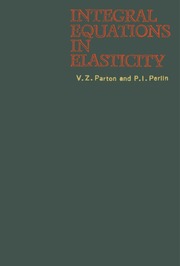Integral Equations In Elasticity | V. Z. Parton, P. I. Perlin
Integral Equations In Elasticity
User Rating: Be the first one!
Author: V. Z. Parton, P. I. Perlin
Added by: mirtitles
Added Date: 2020-08-04
Publication Date: 1982
Language: English
Subjects: mirtitles, physics, mathematics
Collections: mir-titles, additional collections
Pages Count: 600
PPI Count: 600
PDF Count: 1
Total Size: 704.86 MB
PDF Size: 9.53 MB
Extensions: epub, pdf, gz, html, zip, torrent
Downloads: 1.87K
Views: 51.87
Total Files: 17
Media Type: texts
Description
This book presents the fundamentals of the theory of regular and
singular integral equations in the case of one and two variables. The general principles of the theory of approximate methods are consid ered as well as their application for the efficient solution of both regular and singular integral equations. The necessary information is given on the three-dimensional and two-dimensional equations of the theory of elasticity including the formulation of boundary value problems. The book contains the derivation and analysis of various integral equations of the plane problem for both fundamental boundary value problems and mixed problems, and also for bodies with cuts. In the three-dimensional case the construction and analy sis of integral equations are carried out for the first and second fun damental problems.
Emphasis is placed on efficient methods for solving integral equa tions for the plane and three-dimensional problems of elasticity. Examples are given illustrating the advantages of a particular approach. The book is appended with an extensive list of references giving comprehensive information of the subject of investigation.
The emphasis on numerical methods for the solution of integral equations for elastostatic problems corresponds to the author’s con viction that this approach has considerable promise, particularly with the advent of the nearest-generation computers.
singular integral equations in the case of one and two variables. The general principles of the theory of approximate methods are consid ered as well as their application for the efficient solution of both regular and singular integral equations. The necessary information is given on the three-dimensional and two-dimensional equations of the theory of elasticity including the formulation of boundary value problems. The book contains the derivation and analysis of various integral equations of the plane problem for both fundamental boundary value problems and mixed problems, and also for bodies with cuts. In the three-dimensional case the construction and analy sis of integral equations are carried out for the first and second fun damental problems.
Emphasis is placed on efficient methods for solving integral equa tions for the plane and three-dimensional problems of elasticity. Examples are given illustrating the advantages of a particular approach. The book is appended with an extensive list of references giving comprehensive information of the subject of investigation.
The emphasis on numerical methods for the solution of integral equations for elastostatic problems corresponds to the author’s con viction that this approach has considerable promise, particularly with the advent of the nearest-generation computers.
The scope of the book is limited to elastostatic problems though the extension of the methods described to dynamic problems appar ently involves no fundamental difficulties.


 Share on Telegram
Share on Telegram